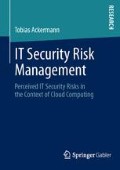Abstract
Cloud Computing is based on the idea that resources, such as software applications, Central Processing Unit (CPU) capacity, and data storage, are no longer processed, kept, and stored at the users’ side. Instead, they are centrally and dynamically provided by the provider over networks, e. g., the Internet (Buxmann et al., 2011b, p. 21). The National Institute of Standards and Technology (NIST) defines Cloud Computing as “a model for enabling ubiquitous, convenient, ondemand network access to a shared pool of configurable computing resources (e. g., networks, servers, storage, applications, and services) that can be rapidly provisioned and released with minimal management effort or service provider interaction” (Mell and Grance, 2011, p. 2).
Access this chapter
Tax calculation will be finalised at checkout
Purchases are for personal use only
Preview
Unable to display preview. Download preview PDF.
Author information
Authors and Affiliations
Rights and permissions
Copyright information
© 2013 Springer Fachmedien Wiesbaden
About this chapter
Cite this chapter
Ackermann, T. (2013). Foundations. In: IT Security Risk Management. Springer Gabler, Wiesbaden. https://doi.org/10.1007/978-3-658-01115-4_2
Download citation
DOI: https://doi.org/10.1007/978-3-658-01115-4_2
Publisher Name: Springer Gabler, Wiesbaden
Print ISBN: 978-3-658-01114-7
Online ISBN: 978-3-658-01115-4
eBook Packages: Business and EconomicsBusiness and Management (R0)

